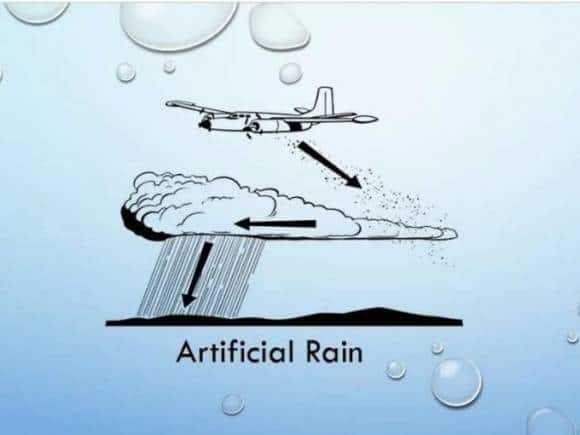



Spearheaded by a cohort of professors from IIT Kanpur, the Delhi government is all set to proceed with cloud seeding-induced artificial rain experiment on November 20 and 21, to combat air pollution in the National Capital. The process involves spraying a mixture of potassium iodide, silver iodide and dry ice on clouds via aircraft, which speeds up the condensation process, leading to rainfall. This subsequently helps in the reduction of PM10 levels, bringing down the AQI levels.
According to reports, the DGCA (Directorate General of Civil Aviation) has given the approval for the aircraft and flares. On November 20, subject to weather conditions, a six seater Cessna plane will fly over Delhi’s sky, introducing the said chemicals into the clouds. The process is said to give Delhiites much-needed respite from air pollution.
The cost of the cloud seeding experiment as communicated by the IIT Kanpur team to Delhi’s Environment Minister Gopal Rai is estimated at Rs 1 lakh per sq. km. The Delhi government has since given its approval to bear the cost of Phase 1 and Phase 2 of cloud seeding, an amount adding up to Rs 13 crore.
The question remains — does artificial rain even work? Is it effective in bringing down the pollution levels? And more importantly — how long will this relief last?
 Artificial rain. (Image via X)A smoking mirror tactic?
Artificial rain. (Image via X)A smoking mirror tactic?“The plan to modify the weather to fight pollution has as much merit as the inoperational smog tower in Delhi”, says Jai Dhar Gupta, a clean air activist and Wharton school alumnus who was a part of the first task force set up by the AAP (Aam Aadmi Party) government in 2015. “It’s ridiculous — the idea of modifying weather to curb pollution unless we cut on the emission source”, says Gupta, who also has a degree in Environmental Science from University of Pennsylvania.
“It is a smoking mirror tactic and makes no sense. Post-rainfall, due to an increase in the humidity in the air, the pollution will increase because everything [fuel, biomass, etc.] will release more pollutants”. Dhar emphasises on the need to change human behaviour, he says “we need to incentivise taking public transport and de-incentivise private vehicles”.
A week’s worth of reliefDhar, who is also the founder of sustainable air solutions company Nirvana Being, says passenger vehicles aren’t a birthright but a privilege that only those who live in non-polluted cities can afford. He feels it is important for Delhi to become a vehicle-free zone to combat pollution.
“We need more long-term solutions”. To that end, it is also important to note that the relief from artificial rain is likely to be short-lived. According to reports, IIT Kanpur scientists predict relief lasting for up to one week in Delhi. “Will a three-four day relief be enough for a city like Delhi? Pollution is a 365 day problem in India. The only way of solving this problem is reducing emission sources — vehicular, constructions, biomass burning and stubble burning,” says Dhar.
Beyond the obvious investment of capital and resources, the success of cloud seeding experiment depends on a plethora of external factors including but not limited to the presence of clouds, wind speed and western disturbances. Thara Prabhakaran, under whose aegis the cloud seeding experiment in Mumbai was carried out in 2018, told The Hindu, “Not all clouds are seedable, not all clouds will make rain. There are clouds that will dissipate on seeding.”
Even then, cloud seeding helped increase the rainfall in Maharashtra only by 18 per cent. “We are spraying clouds with chemicals. These can potentially enter the ecosystem, rivers and groundwater. The moment AQI hits 50 in Paris, the city bans diesel vehicles and makes public transport free. We must practice the same in Delhi,” says the environment expert.
Will drizzle disperse PM2.5?A couple days before Diwali, on November 10, Delhi witnessed an unexpected spell of rain, a slight drizzle which brought down Delhi’s AQI by several hundred points. Can one expect the same from artificial rain? “Precipitation settles PM10 dust but PM2.5 settles only when rain is accompanied by wind. The drizzle on November 10 was relatively still air, so PM10 levels tanked but PM2.5 stayed the same”. Even then, it is likely that many pollutants will still exist in the air and that the relief is only short-lived.
Road ahead, legal recourseNawneet Vibhaw, an environmental lawyer and partner at law firm Shardul Amarchand Mangaldas & Co., has appeared before the Supreme Court and National Green Tribunal (NGT) in matters of environment. “I have received four calls this month from people who wish to file PILs (Public Interest Litigation) due to air pollution. There are folks who have filed it already. A number of judgments have been passed by the court but it is up to the government to implement them, who is already aware of the problems,” Vibhaw says.
When asked about artificial rain, Vibhaw says, “These are desperate measures for emergency situations. Definitely not something that we can rely on for too long. We have clearly failed in our initial endeavors to nip the pollution problem in the bud”.
“I am not very hopeful about the artificial rain because scientifically, the experiment isn’t foolproof. Even if it is successful, it definitely is not a long-term solution. The impact of the chemicals will not just be felt by humans and the groundwater but also by the wildlife.”
As the experts remain sceptical about the success of cloud seeding on November 20 and 21, regardless of the experiment being a success, it is pertinent for Delhiites to work actively towards reducing their carbon footprint.
Discover the latest Business News, Sensex, and Nifty updates. Obtain Personal Finance insights, tax queries, and expert opinions on Moneycontrol or download the Moneycontrol App to stay updated!
Find the best of Al News in one place, specially curated for you every weekend.
Stay on top of the latest tech trends and biggest startup news.